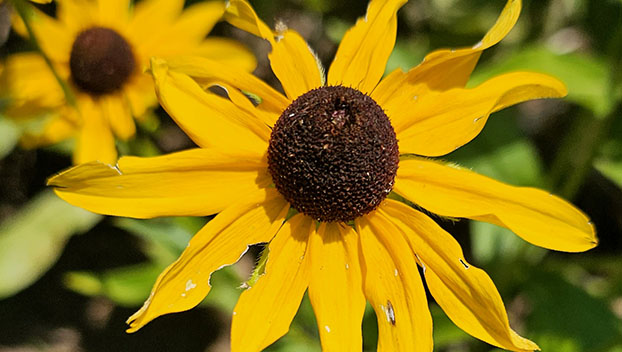Mother Nature’s Garden: Who was Bouncing Bet
Published 2:07 pm Sunday, August 20, 2023

- Both Bouncing Bet and Black-eyed Susan have fanciful common names.
|
Getting your Trinity Audio player ready...
|
Who was Bouncing Bet and what was she doing? And how did black-eyed Susan get her name? The common names of plants are colorful, imaginative, and highly variable.

Some common names refer to the appearance of a plant or its bloom. The V-shaped blooms of Dicentra cucullaria, Dutchman’s breeches, resemble pairs of old fashioned, white, upside-down pants hung on a line to dry. After pollination, the parasitic plant Conopholis americana produces fat seeds on a yellowish spike that resembles a short chubby ear of corn. It’s a favorite food of bears and may comprise as much as 10 percent of their diet. Hence the name bearcorn. Pussytoes (Antennaria spp.) are so named because the velvety flowerheads look like a kitten’s paws. The native orchids (Spiranthes spp.) are commonly known as ladies’ tresses because each plant produces a spiral of small white flowers that have the appearance of braided hair. Rapunzel’s famous braid, perhaps. And then there are the pink lady’s-slippers or moccasin-flowers (Cypripedium acaule). Everyone loves them and knows about their name.
Other common names refer to the use of a plant or its perceived impact. Pedicularis lanceolata is commonly called lousewort because farmers once thought that consumption of this plant would cause their cattle and sheep to become infested with lice. Echium vulgare is known as viper’s bugloss because it was once used to treat snake bites. The common sow thistle (Sonchus oleraceus) is a favorite food of pigs and has immature leaves resembling those of thistles. It’s also known as hare’s thistle.
Other plants have common names with more fanciful meanings. Saponaria officinalis is often referred to as bouncing bet or soapwort. Bet or Betty is an old term for a laundress, and the name Bouncing Bet supposedly refers to the image of the washerwoman vigorously scrubbing her laundry while her flounces bounced about her. When the leaves of Saponaria officinalis are crushed in water, they produce a soap-like lather that is effective in removing grease from clothing. Both monks and farmers used the plant to clean clothes and to increase the bulk of woolen fabric through the fulling process. Perhaps Bouncing Bet was using this plant to clean her laundry.
The common name black-eyed Susan (Rudbeckia hirta) has a more romantic origin. It’s from a popular English ballad written in the early 1700s by John Gay. It tells of a young woman referred to as Black-eyed Susan who boards a ship searching for a crewmember who is her sweetheart. They embrace, she sighs, and he hangs his head because his ship is ready to sail, and they must part.
The common names of plants are fascinating because there is so much lore attached to them. It’s not unusual for a plant to have 15 to 20 common names and for their usage to vary by region. Saponaria officinalis, for example, is also known as old maid’s pink, chimney pink, wild sweet William, lady-by the-garden-gate, dog’s cloves, fuller’s herb, sweet Betty, crowsoap, soaproot, latherwort, soapweed, and scourwort. So many names for one plant. No wonder there is confusion when trying to identify it.
Enjoy the common names, learn the lore behind them, but whenever possible, use the scientific names.
Dr. Cynthia Wood is a master gardener who writes two columns for The Herald. Her email address is cynthia.crewe23930@gmail.com.





